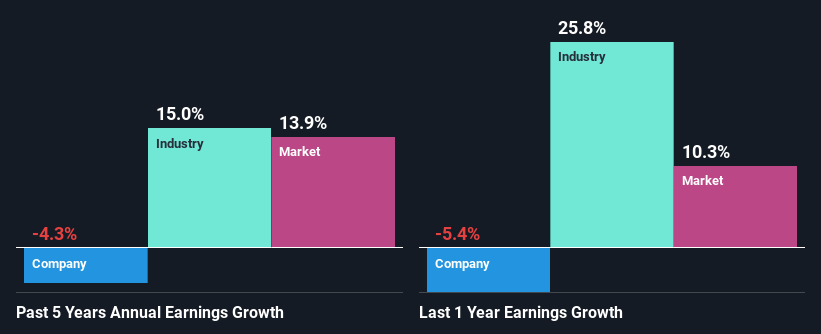Is Kuala Lumpur Kepong Berhad's (KLSE:KLK) Recent Performance Underpinned By Weak Financials?

It is hard to get excited after looking at Kuala Lumpur Kepong Berhad's (KLSE:KLK) recent performance, when its stock has declined 5.1% over the past month. We decided to study the company's financials to determine if the downtrend will continue as the long-term performance of a company usually dictates market outcomes. Particularly, we will be paying attention to Kuala Lumpur Kepong Berhad's ROE today.
ROE or return on equity is a useful tool to assess how effectively a company can generate returns on the investment it received from its shareholders. In simpler terms, it measures the profitability of a company in relation to shareholder's equity.
We've discovered 2 warning signs about Kuala Lumpur Kepong Berhad. View them for free.How Do You Calculate Return On Equity?
Return on equity can be calculated by using the formula:
Return on Equity = Net Profit (from continuing operations) ÷ Shareholders' Equity
So, based on the above formula, the ROE for Kuala Lumpur Kepong Berhad is:
4.9% = RM736m ÷ RM15b (Based on the trailing twelve months to December 2024).
The 'return' is the income the business earned over the last year. That means that for every MYR1 worth of shareholders' equity, the company generated MYR0.05 in profit.
Check out our latest analysis for Kuala Lumpur Kepong Berhad
What Has ROE Got To Do With Earnings Growth?
So far, we've learned that ROE is a measure of a company's profitability. We now need to evaluate how much profit the company reinvests or "retains" for future growth which then gives us an idea about the growth potential of the company. Assuming all else is equal, companies that have both a higher return on equity and higher profit retention are usually the ones that have a higher growth rate when compared to companies that don't have the same features.
Kuala Lumpur Kepong Berhad's Earnings Growth And 4.9% ROE
It is hard to argue that Kuala Lumpur Kepong Berhad's ROE is much good in and of itself. Even when compared to the industry average of 9.1%, the ROE figure is pretty disappointing. Therefore, it might not be wrong to say that the five year net income decline of 4.3% seen by Kuala Lumpur Kepong Berhad was possibly a result of it having a lower ROE. We believe that there also might be other aspects that are negatively influencing the company's earnings prospects. Such as - low earnings retention or poor allocation of capital.
That being said, we compared Kuala Lumpur Kepong Berhad's performance with the industry and were concerned when we found that while the company has shrunk its earnings, the industry has grown its earnings at a rate of 15% in the same 5-year period.

Earnings growth is a huge factor in stock valuation. The investor should try to establish if the expected growth or decline in earnings, whichever the case may be, is priced in. This then helps them determine if the stock is placed for a bright or bleak future. What is KLK worth today? The intrinsic value infographic in our free research report helps visualize whether KLK is currently mispriced by the market.
Is Kuala Lumpur Kepong Berhad Making Efficient Use Of Its Profits?
With a high three-year median payout ratio of 78% (implying that 22% of the profits are retained), most of Kuala Lumpur Kepong Berhad's profits are being paid to shareholders, which explains the company's shrinking earnings. With only a little being reinvested into the business, earnings growth would obviously be low or non-existent. Our risks dashboard should have the 2 risks we have identified for Kuala Lumpur Kepong Berhad.
Additionally, Kuala Lumpur Kepong Berhad has paid dividends over a period of at least ten years, which means that the company's management is determined to pay dividends even if it means little to no earnings growth. Our latest analyst data shows that the future payout ratio of the company is expected to drop to 46% over the next three years. As a result, the expected drop in Kuala Lumpur Kepong Berhad's payout ratio explains the anticipated rise in the company's future ROE to 8.9%, over the same period.
Conclusion
On the whole, Kuala Lumpur Kepong Berhad's performance is quite a big let-down. Because the company is not reinvesting much into the business, and given the low ROE, it's not surprising to see the lack or absence of growth in its earnings. Having said that, looking at current analyst estimates, we found that the company's earnings growth rate is expected to see a huge improvement. To know more about the company's future earnings growth forecasts take a look at this free report on analyst forecasts for the company to find out more.
Valuation is complex, but we're here to simplify it.
Discover if Kuala Lumpur Kepong Berhad might be undervalued or overvalued with our detailed analysis, featuring fair value estimates, potential risks, dividends, insider trades, and its financial condition.
Access Free AnalysisHave feedback on this article? Concerned about the content? Get in touch with us directly. Alternatively, email editorial-team (at) simplywallst.com.
This article by Simply Wall St is general in nature. We provide commentary based on historical data and analyst forecasts only using an unbiased methodology and our articles are not intended to be financial advice. It does not constitute a recommendation to buy or sell any stock, and does not take account of your objectives, or your financial situation. We aim to bring you long-term focused analysis driven by fundamental data. Note that our analysis may not factor in the latest price-sensitive company announcements or qualitative material. Simply Wall St has no position in any stocks mentioned.
About KLSE:KLK
Kuala Lumpur Kepong Berhad
Engages in the plantation, manufacturing, and property development businesses.
Moderate growth potential with acceptable track record.
Similar Companies
Market Insights
Community Narratives



